A Closer Look at Logic of English Foundations D
The Logic of English just recently released their newest level of their Foundations program, which means we’re back to give you a closer look at it (and, they have a pretty sweet giveaway of any level of the Foundations program for you- so keep reading to enter!).
Foundations is, hands down, the best language arts program I have seen for early elementary. Logic of English Foundations D covers everything from phonics, spelling, reading comprehension, grammar, and vocabulary in a fun, and easy to teach way.
How Foundations D Works
Foundations D is the fourth book in the early elementary series from Logic of English. D is different from the other levels in that it adds in a new element, classic children’s stories (like Little Bear, Frog and Toad, Henry and Mudge, Are You My Mother? and more). These fiction offerings are a wonderful complement to the non-fiction readers also used with this level.
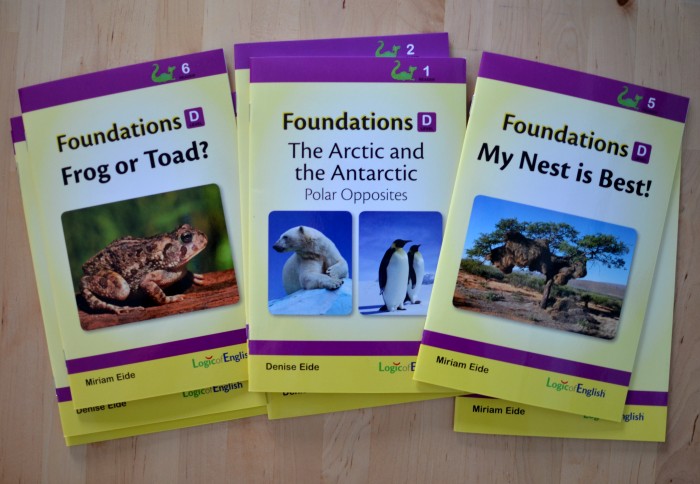
This level continues with the fun, active elements for phonogram practice. Relay races, active games, phonogram basketball, card games, and other creative activities are all included to help your child master their phonograms.
Six new spelling rules are introduced in this level, as well as new grammar and mechanics concepts, and more advanced spelling lists. This level also begins teaching more vocabulary, including prefixes, suffixes, abbreviations, homophomes and contractions.
The most exciting part of this program is the fluency and comprehension parts of the lesson. This program not only helps your child read, but it will teach them to read with expression, use pronunciation keys, use a glossary, recognize elements of the story (plot, conflict and character), make inferences, make predictions and much more.
The writing instruction is also strong in this level. Copywork and dictation are both still present, but your child will also start writing creatively, use graphic organizers, make lists and diagrams, and write a book review.
This is a complete language arts program- there is nothing you are going to need to add to this level.
Teaching a Lesson with Foundations D
A lesson with Foundations D will probably take you an hour, to an hour and a half to complete. You could easily spend even more time on extra phonogram practice, or expanding on the writing lessons (say if your child wanted to edit and write a final draft, or illustrate their work).

Your lesson will start with phonogram practice. You’ll spend some time playing games with your child to make sure they have the new (and old!) phonograms mastered before you move on to the next part of the lesson. Some days, the phonogram practice is just working on old information, and sometimes, a new one or two sounds is introduced and incorporated into the practice.
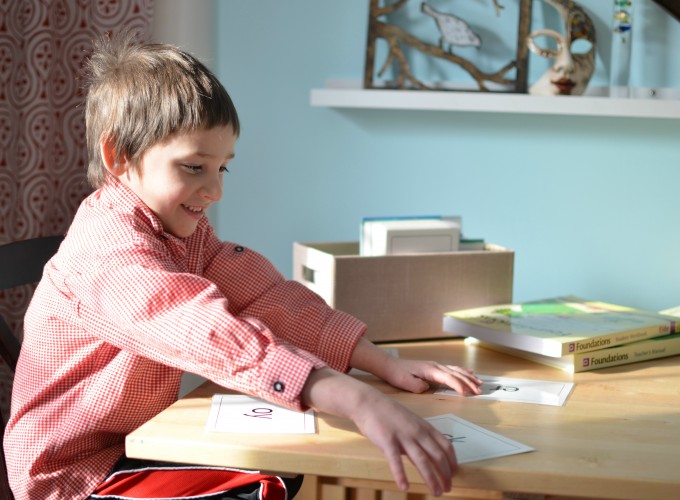
After phonogram practice, you’ll go over the grammar concept for the lesson, and the spelling rules before dictating the spelling list with your child. My kiddo struggles a little with fine motor skills, so instead of writing his spelling words, he builds them with the letter tiles. This part of the lesson can take some time, and there are often pages in the workbook that correspond with it. This section also includes reading words (and finding the patterns in them) to reenforce the spelling and grammar rules.
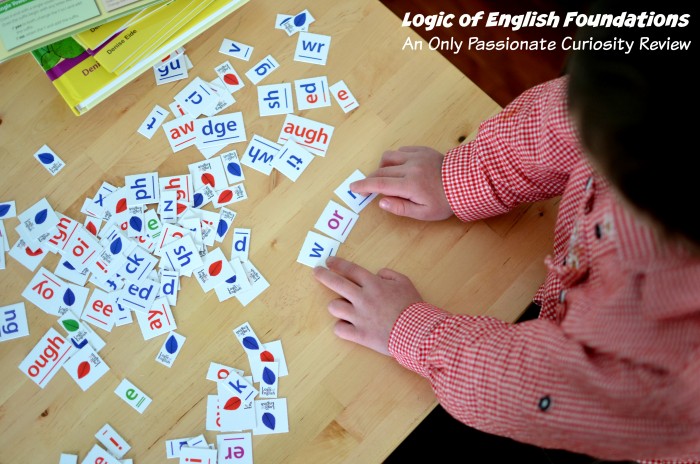
After we go over the spelling list, and really dig into the “why” words are spelled the way they are, it’s time for the reading and writing part of the lesson. My wiggily boy often can’t do more than this in one sitting, so sometimes, we break the lesson down into two days instead of one… and sometimes even longer (either stopping just before, or just after the spelling list). Sometimes, we do a morning and afternoon session, but either way, we almost never do it all in one sitting.
A note- this level has 40 lessons. How you do them is up to you. You could do the program daily, do one lesson a week, do one lesson over two days- it’s really going to come down to your child. I wouldn’t worry too much about how quickly, or slowly you get the program done, because you don’t want to rush phonics. Take as long as it takes for your child to master the phonograms for each lesson, and be able to spell and explain the words- even if that means you are doing the same spelling list three days in a row. Trust your kiddo, and your gut on this one. Foundations D will probably take my child the better part of a school year, and I am okay with that.
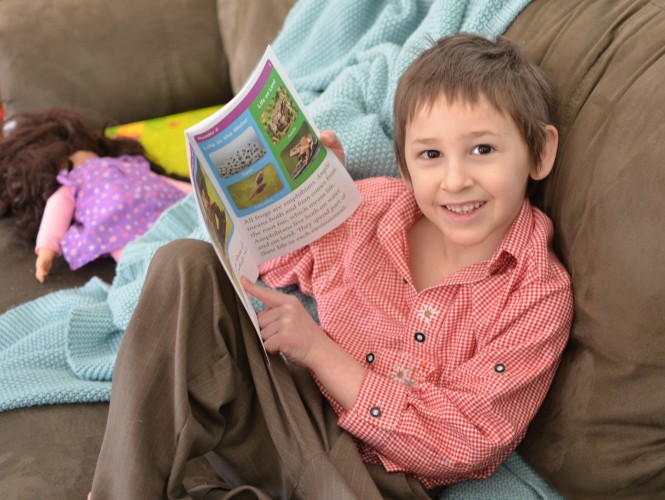
So- the reading, fluency, and writing sections….
First, your child will chit chat with you about the book they read. They’ll discuss if it was fiction or non-fiction, look at specific pages and passages to discuss things like the characters and the plot, to practice reading with expression, and more. They aren’t just sent off to read- reading is really a team effort, and they are taught from the start to actively read, to question and infer, and relate to the story. They are also taught to respond and learn from what they are reading.
This seems like such a simple thing, but it’s something I struggled with when it came to my oldest (who didn’t get to use Foundations D!). This program really does a wonderful job with helping kids become better readers.
Then, your child will do some sort of writing activity. This can be anything from copywork, to filling out graphic organizers, to writing imaginative pieces. If you have a child like mine, you may do these activities orally, or as a team (they can dictate, you can write). You can also write on a paper and have your child copy their words onto their papers. For the writing section, the process is more important than the product, so it is okay to adapt the lessons so they work for your specific situation.
Finally, you’ll end with another spelling activity. Oftentimes, these are games intended to help your child review what was taught in the lesson.
Where to Start With Foundations
For your child to start with Foundations, they need to already be reading at a basic level, and have an understanding of most of the phonograms as taught by LOE. If you have not done books A-C, I wouldn’t discourage you from using D (I really do think you can enter into the program at this point) but you should take some time preparing before you start with the lessons. To get ready for D, I would recommend getting the Logic of English Phonograms app and having your kids play on that until they know most of the phonograms, and I’d also pick up the phonogram cards, game cards (two decks) and the game book. These tools will allow you to practice the phonograms and get up to speed with that part of the system. With diligence and practice, this should take you just a month or two. If you’d like to use Foundations D next year, you have plenty of time over the summer to get those phonograms down!
If your child is not already reading, start with Foundations A, which teaches the basic (single letter) phonograms, pre-reading skills (like chunking, blending and breaking words down by syllables). You can also jump right into Essentials if you have an older child.
****After I posted originally, I had a little chat with LOE, so here is an added note from The Logic of English****
I think it’s *possible* someone could get through D successfully if he had learned all the basic phonograms and was reading but hadn’t completed B-C. However, I would not anticipate it working well in most cases. We’ve had to clarify on this a lot with people who think of curriculum in terms of grade level rather than what skills a student has learned and just want to start at D because their child is older. This won’t work if the child has not learned the prior skills D assumes and builds on, which have been carefully built upon each other and practiced and strengthened in getting to that point, so I fear that for each one who manages it successfully three others will struggle and be confused.
Here’s why: it’s not just the 74 phonograms. To be completely successful in D, in addition to the 74 phonograms, the children (AND the parent!) will need to know and be very comfortable with schwa and where/why it happens, syllables and syllable stress, segmenting and blending, the process of marking and analyzing words…seven reasons for a silent E and 13 other spelling rules … That’s a lot of material — too much, I think, to try to cram together so you can start Foundations at D.
We do not recommend starting at D and believe anyone whose child is too old to start Foundations will be best served by Essentials.
On the other hand, it is totally fine to start Foundations B! Children who know all the sounds of A-Z and who can blend and segment well, read CVC short vowel words (not sight words), and hand write all the lowercase can start at B. It’s in B that students start learning multi-letter phonograms and spelling rules. Hope this helps!
So- there you have it, right from them- Start at A, B (if your child can read CVC words, i.e. Dog, and knows the single letter phonograms), or Essentials depending on your child’s readiness and ability. I think perhaps my original gut reaction that D would be an okay place to start probably comes down to my family having used LOE for so many years- I didn’t think of the little nuances that are taught along with the phonograms. You should probably take Liz’s (of LOE) word for it.
A Closer Look at LOE Foundations D
Hopefully, everything I have said makes sense so far, but if not, hopefully this will help! We’re trying something new, y’all! If you all lived next door to me, I’d probably invite you over to look at these products in person. There’s something about holding the book in your hand that just makes a world of difference in deciding if a curriculum will work for you or not. Since I can’t do that, I recorded this video for you this morning. I hope you find it helpful (and, um, don’t laugh at me too much, I’ll get better at this the more I do it!)
Read our other posts on The Logic of English
Logic of English Essentials Review
Why Logic of English Works for Us
My Baby Can Read!
Teaching an Wiggily Child to Read
How to do Spelling Dictation in your Homeschool
Enter to Win!
I am thrilled that Logic of English has agreed to host a giveaway on the blog today. The winner will get to choose one teachers manual and workbook from the Foundations series (A,B,C, or D). If you are new to LOE, there may be other materials you need to get going, but don’t worry, if you win, I’ll be happy to give you the rundown so you know what you need, and what is frosting on the cake!

Use the giveaway widget below to enter to win!
 See all of our reviews
See all of our reviews



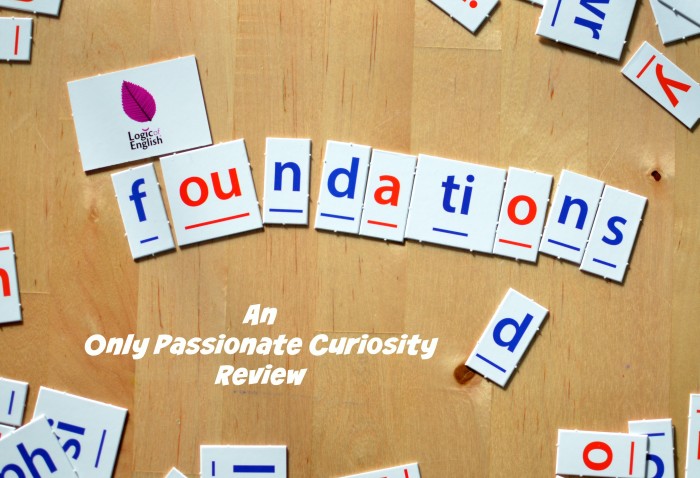
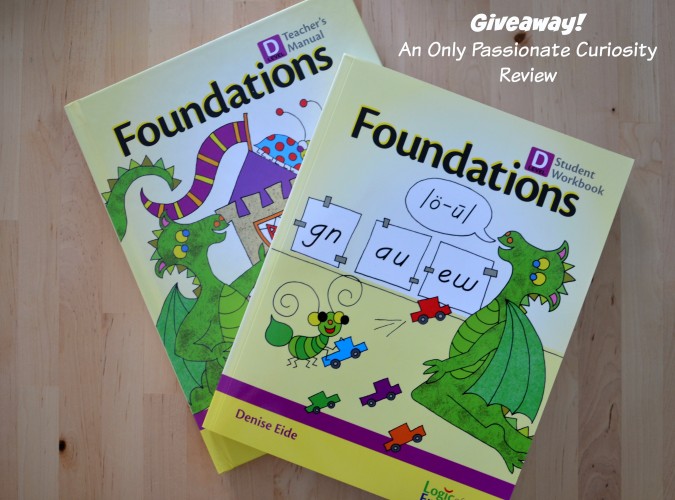

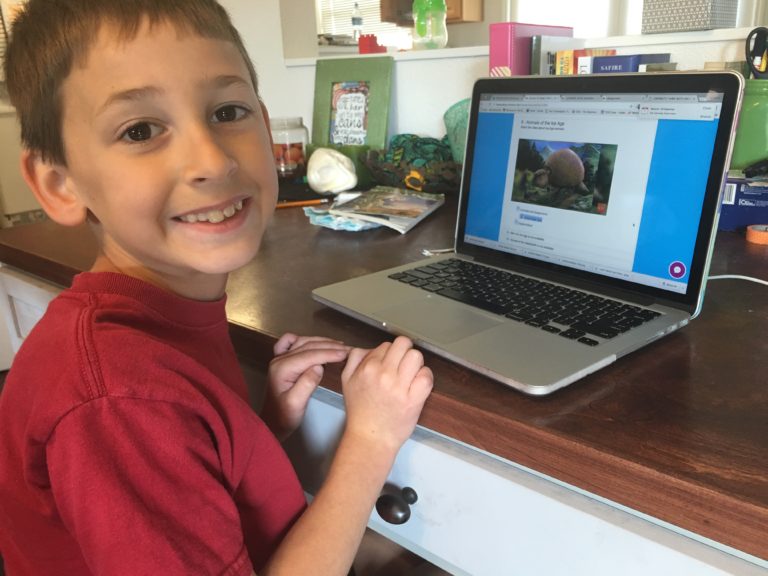

This is an older post, so I don’t know if you’ll see this. But, we are looking seriously at switching to Logic of English in the near future. My son is in kindergarten this year. He is gifted/autistic and taught himself how to read when he was 3, but as a grammar nerd, I want him to learn the rules of language, not just read books. He reads books like Frog and Toad, but cannot tell me how to put together a sentence. Would you suggest starting at level B? He has such a mixed skill set that I’m really struggling to find a lang arts program to fit us.
You could start in B with a child who is reading- you wouldn’t want him to get totally burnt out on the program by starting too far behind. But, IF you do this, make sure you invest in the Logic of English apps and work with him on ALL the sounds each letter makes before beginning. You’ll want him to be fluent in those letter sounds (especially vowels) before jumping in. I hope that helps!
Hi! I came across your post regarding Foundations D as well as your other posts about the Foundations and Essentials program. I would like to thank you for creating a video because it was helpful to determine whether my son should start with Essentials or with Foundations B-D (as LOE suggests). My son is 6 (1st grade) and will have just turned 7 when he starts second grade. We are using K12 right now with our homeschool charter and he is a beginning reader, but not yet fluently. I feel that he was not taught the “why” of a word and have left gaps in his reading or progress. After watching your video, I believe the best starting point would be Foundations as when you showed the D book, there were words I know my son would not know how to read. That being said, I feel that it lacks in the grammar part, would you recommend supplementing with another grammar program, or would you say it would be sufficient?
Hi Ana!
In my experience, grammar in the early years isn’t worth a huge amount of time or money investment. In the third grade, we used the grammar portion along with LOE, and in the fifth grade, we started using more intense programs (like Analytical grammar). I did use grammar programs with Bug when he was little, but with the younger kids, this is what I am doing instead:
1. Watch lots and lots of schoolhouse rock: (around 8 dollars) http://amzn.to/21doNiA
2. Read this book (it’s beautiful): http://amzn.to/21dphoV
3. Add in the perfect punctuation pop up book if needed: http://amzn.to/21dp5Gc
I always read Harry Potter, now we read Percy Jackson.
I would love to try with my daughter who is dyslexic. we read magic tree house and american girl series
I would love to try with my daughter who is dyslexic
Favorite book to read aloud? I don’t know if I have one! The Brambly Hedge books are definitely high on my list.
I would love to.try this with my daughter! It sounds like an amazing program that builds up kids as readers.
My favorite books at the moment are the Math Adventures like “Sir Cumference and All the King’s Tens” and scholastic “You wouldn’t want to be sick in the 16th Century!” Both these series are fun to read, marvelous vocabulary and clear concise concepts in math and science explained in memorable manner. Cheers, mildred.
Chicken Soup with RIce
Would love to try this out.
I am intrigued by LOE. Interested to learn more!
We just read John Lithgow’s book I Got Two Dogs to my son. We LOVED listening to the CD. The song is still stuck in my head!
We just read John Lithgow’s book “I Got Two Dogs” to my son. We LOVED listening to the CD. The song is still stuck in my head!
My favorite book to read to my girls is The Very Hungry Catapillar or Blueberries for Sal
My favorite book to read to my kiddos is Love You Forever!! We all have it memorized.
My favorite book to read to my kiddos is Love You Forever!! We all have it memorized 🙂
Right now I have two favorites book to read aloud, Caps For Sale and Dr. Suess’ Wacky Wednesday. We have been having such fun with both!
I’m new to the homeschooling. These look like great resources. I’m excited about the opportunity to shape my children’s education the way I believe it should be! Thank you for the opportunity to win and try some great products.
My favorite read alouds are picture books like Laura Numeroff’s books and some Eric Carle’s.
My favorite read alouds are the mouse who books and Eric Carle books (except Brown bear which I don’t like).
we love all the frog and toad books and my girls also love reading the American girl stories together
our favourite read alouds change from one week to the next, but we are currently enjoying Charlotte’s web together!
We are really enjoying all the Dr. Seuss books
Charlotte’s Web is my favorite read-aloud.
Thank you for the opportunity. The review is very informative and helpful.
I love reading to my children even as they now begin to read on their own. Lately we have been enjoying the classic fairy tales of Brothers Grimm and H. C. Andersen together.
This is a very informative review. Thank you!
I love reading to my children and our favourites change. But some of the ones that we go to over and over are Dr. Seuss, Eric Carle, the Little House series, and classic fairy tales.
I love reading goodnight, goodnight construction site to my son.
Make way for Ducklings is a favorite, but it is almost impossible to choose–and I see quite a few titles above that are also hits here in our home. Logic of English gives readers great tools!
I love to read Guess How Much I Love You to them!
We just started the LOE Foundations A and I love it so far! Thank you for your post reviewing the curriculum. When I was looking around at what curriculum to use, I did not find too many on LOE foundations.
I think our favorite book to read is our Virginia Burton treasury with Mike Mulligan, The Little House, Katy and the Big Snow, and Maybelle the Cable Car.
I love Elephant and Piggie books. My big kids like Percy Jackson.
We also LLOOVVEE the LOE curriculum! ! We are currently on Foundations B. My favorite part is that the kids are giggling and having a great time while learning complex English material.
We have a huge bookshelf of books. I agree it’s so hard to pick just one, but if I must our kids really like the Bible 🙂
We like the Illustrated ESV Family BIble and The Story for Children. We are also into Eric Carle books like The Grouchy Ladybug.
Many! I’ve read (aloud) Chronicles of Narnia at least ten times over the years.
So many books we love to read together. Over the years, I read aloud the entire Chronicles of Narnia at least 10 times.
Not sure my comment posted…Blueberries for Sal!
Blueberries for Sal! We love LOE and are almost finished with Foundations B!
We love Logic of English. I used Essentials with my older son. My younger son started playing with the apps when he was 3 or 4, and I started him on Foundations A last spring when he was 5. We’re on B now, and he’s doing quite well!
I don’t know if I can pick a favorite read-aloud, but we love the Elephant and Piggy books. 🙂
My children enjoyed Mr. Popper’s Penguins.
We love LOE and are part way through foundations a!
My girls love Green Eggs and Ham.
It’s hard to pick a favorite book but my son’t favorites lately include “The Day the Crayons Quit”, “Good Night, Good Night, Construction Site”, and “It’s Hard Being Five.” Would LOVE to win this program!
I enjoy Goodnight Gorilla with my littlest.
I love reading Goodnight Moon to my kids.
Right now we are on a streak of Thornton Burgess nature books.
We Love reading Brown Bear, Brown Bear.
I love this! Have never heard of it before but it looks fun and interesting.
We love the book If You Give a Mouse a Cookie.
I love to read Peter Pan to my kiddos. We ALL enjoy it!
We enjoy reading aloud the James Herriot Treasury of Animal Stories! It is a great book for young and old.
I love reading Character Trails to my kids. They always ask for another story!
We love Foundations A and would love to win B! Our favorite books to read aloud are the Little House books.
My son is delayed and a first time homeschooler, this looks wonderful for helping children with delays. My son is sitting here and loves you site!
We are really enjoying Story of the World right now.
We read a different chapter book every month with the older boys. With my toddler, our favorite read aloud books are the Franklin the Turtle books 🙂
We really enjoy Is Your Mama A Llama.
I would LOVE, LOVE, LOVE to win this. I’ve been wanting to buy the level A set for my kindergartener but it is out of my budget at the moment.
Oops, and favorite read aloud is the Big Red Barn by Margaret Wise Brown and illustrated by Felicia Bond. Not sure it’s my son’s favorite book but I LOVE it!
Chicka Chicka Boom Boom is one of our favorites, as is Pete the Cat and His Four Groovy Buttons.
My children love Room on the Broom by Julia Donaldson! I think we’ve read it at least a hundred times. I bought it for Halloween themed reading, but it has lasted far beyond that!
such a great review to read. I have several friends who use LOE and rave about it. Would love to win 🙂
We read Good Night Moon in Hebrew each night before bed.
We really like reading the Amelia Bedelia books.
We really like the Amelia Bedelia books.
I love to read Stellaluna aloud to my kids. We all enjoy the story very much.